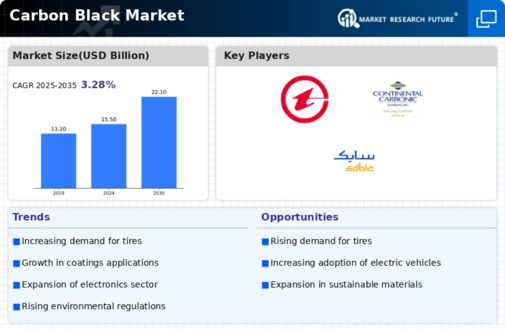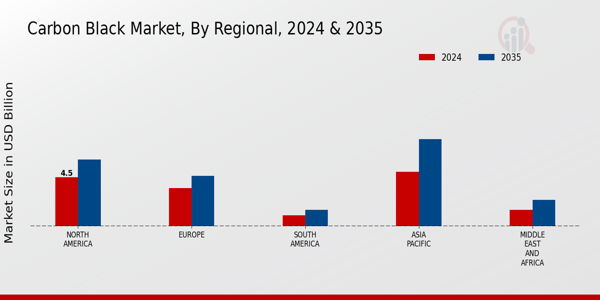Tires
Coatings
Plastics
Inks
Adhesives
Natural Black
Synthetic Black
Furnace Black
Channel Black
Acetylene Black
Automotive
Construction
Electronics
Consumer Goods
Agriculture
Powder
Granules
Pellets
North America
Europe
South America
Asia Pacific
Middle East and Africa
North America Outlook (USD Billion, 2019-2035)
North America Carbon Black Market by Application Type
Tires
Coatings
Plastics
Inks
Adhesives
North America Carbon Black Market by Type
Natural Black
Synthetic Black
Furnace Black
Channel Black
Acetylene Black
North America Carbon Black Market by End Use Industry Type
Automotive
Construction
Electronics
Consumer Goods
Agriculture
North America Carbon Black Market by Form Type
Powder
Granules
Pellets
North America Carbon Black Market by Regional Type
US
Canada
US Outlook (USD Billion, 2019-2035)
US Carbon Black Market by Application Type
Tires
Coatings
Plastics
Inks
Adhesives
US Carbon Black Market by Type
Natural Black
Synthetic Black
Furnace Black
Channel Black
Acetylene Black
US Carbon Black Market by End Use Industry Type
Automotive
Construction
Electronics
Consumer Goods
Agriculture
US Carbon Black Market by Form Type
Powder
Granules
Pellets
CANADA Outlook (USD Billion, 2019-2035)
CANADA Carbon Black Market by Application Type
Tires
Coatings
Plastics
Inks
Adhesives
CANADA Carbon Black Market by Type
Natural Black
Synthetic Black
Furnace Black
Channel Black
Acetylene Black
CANADA Carbon Black Market by End Use Industry Type
Automotive
Construction
Electronics
Consumer Goods
Agriculture
CANADA Carbon Black Market by Form Type
Powder
Granules
Pellets
Europe Outlook (USD Billion, 2019-2035)
Europe Carbon Black Market by Application Type
Tires
Coatings
Plastics
Inks
Adhesives
Europe Carbon Black Market by Type
Natural Black
Synthetic Black
Furnace Black
Channel Black
Acetylene Black
Europe Carbon Black Market by End Use Industry Type
Automotive
Construction
Electronics
Consumer Goods
Agriculture
Europe Carbon Black Market by Form Type
Powder
Granules
Pellets
Europe Carbon Black Market by Regional Type
Germany
UK
France
Russia
Italy
Spain
Rest of Europe
GERMANY Outlook (USD Billion, 2019-2035)
GERMANY Carbon Black Market by Application Type
Tires
Coatings
Plastics
Inks
Adhesives
GERMANY Carbon Black Market by Type
Natural Black
Synthetic Black
Furnace Black
Channel Black
Acetylene Black
GERMANY Carbon Black Market by End Use Industry Type
Automotive
Construction
Electronics
Consumer Goods
Agriculture
GERMANY Carbon Black Market by Form Type
Powder
Granules
Pellets
UK Outlook (USD Billion, 2019-2035)
UK Carbon Black Market by Application Type
Tires
Coatings
Plastics
Inks
Adhesives
UK Carbon Black Market by Type
Natural Black
Synthetic Black
Furnace Black
Channel Black
Acetylene Black
UK Carbon Black Market by End Use Industry Type
Automotive
Construction
Electronics
Consumer Goods
Agriculture
UK Carbon Black Market by Form Type
Powder
Granules
Pellets
FRANCE Outlook (USD Billion, 2019-2035)
FRANCE Carbon Black Market by Application Type
Tires
Coatings
Plastics
Inks
Adhesives
FRANCE Carbon Black Market by Type
Natural Black
Synthetic Black
Furnace Black
Channel Black
Acetylene Black
FRANCE Carbon Black Market by End Use Industry Type
Automotive
Construction
Electronics
Consumer Goods
Agriculture
FRANCE Carbon Black Market by Form Type
Powder
Granules
Pellets
RUSSIA Outlook (USD Billion, 2019-2035)
RUSSIA Carbon Black Market by Application Type
Tires
Coatings
Plastics
Inks
Adhesives
RUSSIA Carbon Black Market by Type
Natural Black
Synthetic Black
Furnace Black
Channel Black
Acetylene Black
RUSSIA Carbon Black Market by End Use Industry Type
Automotive
Construction
Electronics
Consumer Goods
Agriculture
RUSSIA Carbon Black Market by Form Type
Powder
Granules
Pellets
ITALY Outlook (USD Billion, 2019-2035)
ITALY Carbon Black Market by Application Type
Tires
Coatings
Plastics
Inks
Adhesives
ITALY Carbon Black Market by Type
Natural Black
Synthetic Black
Furnace Black
Channel Black
Acetylene Black
ITALY Carbon Black Market by End Use Industry Type
Automotive
Construction
Electronics
Consumer Goods
Agriculture
ITALY Carbon Black Market by Form Type
Powder
Granules
Pellets
SPAIN Outlook (USD Billion, 2019-2035)
SPAIN Carbon Black Market by Application Type
Tires
Coatings
Plastics
Inks
Adhesives
SPAIN Carbon Black Market by Type
Natural Black
Synthetic Black
Furnace Black
Channel Black
Acetylene Black
SPAIN Carbon Black Market by End Use Industry Type
Automotive
Construction
Electronics
Consumer Goods
Agriculture
SPAIN Carbon Black Market by Form Type
Powder
Granules
Pellets
REST OF EUROPE Outlook (USD Billion, 2019-2035)
REST OF EUROPE Carbon Black Market by Application Type
Tires
Coatings
Plastics
Inks
Adhesives
REST OF EUROPE Carbon Black Market by Type
Natural Black
Synthetic Black
Furnace Black
Channel Black
Acetylene Black
REST OF EUROPE Carbon Black Market by End Use Industry Type
Automotive
Construction
Electronics
Consumer Goods
Agriculture
REST OF EUROPE Carbon Black Market by Form Type
Powder
Granules
Pellets
APAC Outlook (USD Billion, 2019-2035)
APAC Carbon Black Market by Application Type
Tires
Coatings
Plastics
Inks
Adhesives
APAC Carbon Black Market by Type
Natural Black
Synthetic Black
Furnace Black
Channel Black
Acetylene Black
APAC Carbon Black Market by End Use Industry Type
Automotive
Construction
Electronics
Consumer Goods
Agriculture
APAC Carbon Black Market by Form Type
Powder
Granules
Pellets
APAC Carbon Black Market by Regional Type
China
India
Japan
South Korea
Malaysia
Thailand
Indonesia
Rest of APAC
CHINA Outlook (USD Billion, 2019-2035)
CHINA Carbon Black Market by Application Type
Tires
Coatings
Plastics
Inks
Adhesives
CHINA Carbon Black Market by Type
Natural Black
Synthetic Black
Furnace Black
Channel Black
Acetylene Black
CHINA Carbon Black Market by End Use Industry Type
Automotive
Construction
Electronics
Consumer Goods
Agriculture
CHINA Carbon Black Market by Form Type
Powder
Granules
Pellets
INDIA Outlook (USD Billion, 2019-2035)
INDIA Carbon Black Market by Application Type
Tires
Coatings
Plastics
Inks
Adhesives
INDIA Carbon Black Market by Type
Natural Black
Synthetic Black
Furnace Black
Channel Black
Acetylene Black
INDIA Carbon Black Market by End Use Industry Type
Automotive
Construction
Electronics
Consumer Goods
Agriculture
INDIA Carbon Black Market by Form Type
Powder
Granules
Pellets
JAPAN Outlook (USD Billion, 2019-2035)
JAPAN Carbon Black Market by Application Type
Tires
Coatings
Plastics
Inks
Adhesives
JAPAN Carbon Black Market by Type
Natural Black
Synthetic Black
Furnace Black
Channel Black
Acetylene Black
JAPAN Carbon Black Market by End Use Industry Type
Automotive
Construction
Electronics
Consumer Goods
Agriculture
JAPAN Carbon Black Market by Form Type
Powder
Granules
Pellets
SOUTH KOREA Outlook (USD Billion, 2019-2035)
SOUTH KOREA Carbon Black Market by Application Type
Tires
Coatings
Plastics
Inks
Adhesives
SOUTH KOREA Carbon Black Market by Type
Natural Black
Synthetic Black
Furnace Black
Channel Black
Acetylene Black
SOUTH KOREA Carbon Black Market by End Use Industry Type
Automotive
Construction
Electronics
Consumer Goods
Agriculture
SOUTH KOREA Carbon Black Market by Form Type
Powder
Granules
Pellets
MALAYSIA Outlook (USD Billion, 2019-2035)
MALAYSIA Carbon Black Market by Application Type
Tires
Coatings
Plastics
Inks
Adhesives
MALAYSIA Carbon Black Market by Type
Natural Black
Synthetic Black
Furnace Black
Channel Black
Acetylene Black
MALAYSIA Carbon Black Market by End Use Industry Type
Automotive
Construction
Electronics
Consumer Goods
Agriculture
MALAYSIA Carbon Black Market by Form Type
Powder
Granules
Pellets
THAILAND Outlook (USD Billion, 2019-2035)
THAILAND Carbon Black Market by Application Type
Tires
Coatings
Plastics
Inks
Adhesives
THAILAND Carbon Black Market by Type
Natural Black
Synthetic Black
Furnace Black
Channel Black
Acetylene Black
THAILAND Carbon Black Market by End Use Industry Type
Automotive
Construction
Electronics
Consumer Goods
Agriculture
THAILAND Carbon Black Market by Form Type
Powder
Granules
Pellets
INDONESIA Outlook (USD Billion, 2019-2035)
INDONESIA Carbon Black Market by Application Type
Tires
Coatings
Plastics
Inks
Adhesives
INDONESIA Carbon Black Market by Type
Natural Black
Synthetic Black
Furnace Black
Channel Black
Acetylene Black
INDONESIA Carbon Black Market by End Use Industry Type
Automotive
Construction
Electronics
Consumer Goods
Agriculture
INDONESIA Carbon Black Market by Form Type
Powder
Granules
Pellets
REST OF APAC Outlook (USD Billion, 2019-2035)
REST OF APAC Carbon Black Market by Application Type
Tires
Coatings
Plastics
Inks
Adhesives
REST OF APAC Carbon Black Market by Type
Natural Black
Synthetic Black
Furnace Black
Channel Black
Acetylene Black
REST OF APAC Carbon Black Market by End Use Industry Type
Automotive
Construction
Electronics
Consumer Goods
Agriculture
REST OF APAC Carbon Black Market by Form Type
Powder
Granules
Pellets
South America Outlook (USD Billion, 2019-2035)
South America Carbon Black Market by Application Type
Tires
Coatings
Plastics
Inks
Adhesives
South America Carbon Black Market by Type
Natural Black
Synthetic Black
Furnace Black
Channel Black
Acetylene Black
South America Carbon Black Market by End Use Industry Type
Automotive
Construction
Electronics
Consumer Goods
Agriculture
South America Carbon Black Market by Form Type
Powder
Granules
Pellets
South America Carbon Black Market by Regional Type
Brazil
Mexico
Argentina
Rest of South America
BRAZIL Outlook (USD Billion, 2019-2035)
BRAZIL Carbon Black Market by Application Type
Tires
Coatings
Plastics
Inks
Adhesives
BRAZIL Carbon Black Market by Type
Natural Black
Synthetic Black
Furnace Black
Channel Black
Acetylene Black
BRAZIL Carbon Black Market by End Use Industry Type
Automotive
Construction
Electronics
Consumer Goods
Agriculture
BRAZIL Carbon Black Market by Form Type
Powder
Granules
Pellets
MEXICO Outlook (USD Billion, 2019-2035)
MEXICO Carbon Black Market by Application Type
Tires
Coatings
Plastics
Inks
Adhesives
MEXICO Carbon Black Market by Type
Natural Black
Synthetic Black
Furnace Black
Channel Black
Acetylene Black
MEXICO Carbon Black Market by End Use Industry Type
Automotive
Construction
Electronics
Consumer Goods
Agriculture
MEXICO Carbon Black Market by Form Type
Powder
Granules
Pellets
ARGENTINA Outlook (USD Billion, 2019-2035)
ARGENTINA Carbon Black Market by Application Type
Tires
Coatings
Plastics
Inks
Adhesives
ARGENTINA Carbon Black Market by Type
Natural Black
Synthetic Black
Furnace Black
Channel Black
Acetylene Black
ARGENTINA Carbon Black Market by End Use Industry Type
Automotive
Construction
Electronics
Consumer Goods
Agriculture
ARGENTINA Carbon Black Market by Form Type
Powder
Granules
Pellets
REST OF SOUTH AMERICA Outlook (USD Billion, 2019-2035)
REST OF SOUTH AMERICA Carbon Black Market by Application Type
Tires
Coatings
Plastics
Inks
Adhesives
REST OF SOUTH AMERICA Carbon Black Market by Type
Natural Black
Synthetic Black
Furnace Black
Channel Black
Acetylene Black
REST OF SOUTH AMERICA Carbon Black Market by End Use Industry Type
Automotive
Construction
Electronics
Consumer Goods
Agriculture
REST OF SOUTH AMERICA Carbon Black Market by Form Type
Powder
Granules
Pellets
MEA Outlook (USD Billion, 2019-2035)
MEA Carbon Black Market by Application Type
Tires
Coatings
Plastics
Inks
Adhesives
MEA Carbon Black Market by Type
Natural Black
Synthetic Black
Furnace Black
Channel Black
Acetylene Black
MEA Carbon Black Market by End Use Industry Type
Automotive
Construction
Electronics
Consumer Goods
Agriculture
MEA Carbon Black Market by Form Type
Powder
Granules
Pellets
MEA Carbon Black Market by Regional Type
GCC Countries
South Africa
Rest of MEA
GCC COUNTRIES Outlook (USD Billion, 2019-2035)
GCC COUNTRIES Carbon Black Market by Application Type
Tires
Coatings
Plastics
Inks
Adhesives
GCC COUNTRIES Carbon Black Market by Type
Natural Black
Synthetic Black
Furnace Black
Channel Black
Acetylene Black
GCC COUNTRIES Carbon Black Market by End Use Industry Type
Automotive
Construction
Electronics
Consumer Goods
Agriculture
GCC COUNTRIES Carbon Black Market by Form Type
Powder
Granules
Pellets
SOUTH AFRICA Outlook (USD Billion, 2019-2035)
SOUTH AFRICA Carbon Black Market by Application Type
Tires
Coatings
Plastics
Inks
Adhesives
SOUTH AFRICA Carbon Black Market by Type
Natural Black
Synthetic Black
Furnace Black
Channel Black
Acetylene Black
SOUTH AFRICA Carbon Black Market by End Use Industry Type
Automotive
Construction
Electronics
Consumer Goods
Agriculture
SOUTH AFRICA Carbon Black Market by Form Type
Powder
Granules
Pellets
REST OF MEA Outlook (USD Billion, 2019-2035)
REST OF MEA Carbon Black Market by Application Type
Tires
Coatings
Plastics
Inks
Adhesives
REST OF MEA Carbon Black Market by Type
Natural Black
Synthetic Black
Furnace Black
Channel Black
Acetylene Black
REST OF MEA Carbon Black Market by End Use Industry Type
Automotive
Construction
Electronics
Consumer Goods
Agriculture
REST OF MEA Carbon Black Market by Form Type
Powder
Granules
Pellets







Leave a Comment